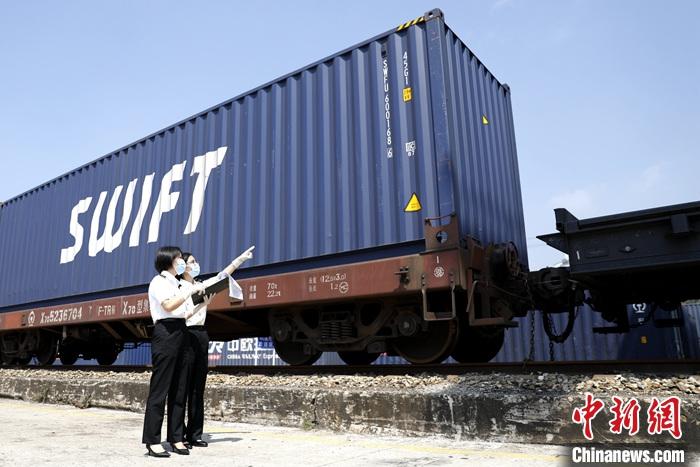China News Service, October 22. Liu Zhenfang, Director of the National Railway Administration, said on the 22nd that the China-Europe railway has developed rapidly. As of the end of September 2020, it has operated more than 30,000 trains, which has become an important achievement and outstanding highlight of the “Belt and Road” construction.
On September 11, a batch of bonded goods on the China-Europe train passed the checkpoint of Xiamen Haicang Bonded Port Area. This is the first time that Xiamen has ushered in a complete train of China-Europe trains carrying imported bonded goods.
The picture shows on-site supervision by customs officers of Xiamen Customs.
Photo by China News Agency reporter Li Siyuan
On the afternoon of the 22nd, the State Council Information Office held a press conference on the development achievements of the "13th Five-Year Plan" of transportation.
At the meeting, Liu Zhenfang introduced that during the 13th Five-Year Plan period, the railway industry will further promote the structural reform of the railway supply side, strive to promote the high-quality development of railways. Serving the national strategy and promoting economic and social development played a leading role.
One is the rapid development of road network construction.
The main framework of the "four vertical and four horizontal" high-speed railways has been fully completed, the main channel of the "eight vertical and eight horizontal" high-speed railways and the general-speed trunk railway have been accelerated, and the inter-city railways in key areas have been rapidly advanced.
A large number of new lines such as the smart Beijing-Zhangjiakou high-speed railway and the Haoji Railway, a heavy-duty channel for North Coal and South Transportation, have been put into operation.
The layout of the national road network has been continuously optimized, the quality of the road network has been significantly improved, the railway network in the central and western regions has been continuously improved, and the hubs and supporting facilities have been continuously strengthened.
As of the end of 2019, the national railway operating mileage reached 139,000 kilometers, including 35,000 kilometers of high-speed railways. By the end of the "13th Five-Year Plan", a railway network with reasonable layout, wide coverage, clear hierarchy, safe and efficient will be basically formed.
Second, the transportation quality has been significantly improved.
The railway industry focuses on meeting the people's growing demand for railway transportation, vigorously implements structural reforms on the railway supply side, and continues to improve transportation supply capacity, service quality, and safety.
From 2015 to 2019, the national railway passenger volume increased by 9.6% annually, and the freight volume increased by 6.9% annually. The passenger and cargo transportation capacity was greatly improved, the passenger travel was more convenient, and the transportation of key materials such as energy and resources was effectively guaranteed.
The level of railway transportation services has been significantly improved, and passenger tickets and freight bills have been "electronic".
Emergency support capabilities have been significantly enhanced, and transportation safety has continued to be stable, especially the world's leading high-speed rail operation safety.
The third is the overall improvement of the equipment level.
A high-speed rail construction and equipment manufacturing technology system with independent intellectual property rights has been formed.
The Chinese standard EMU of Fuxing has achieved commercial operation at a speed of 350 kilometers per hour, and a series of product pedigrees have basically taken shape.
For the first time in the world, the intelligent EMU has achieved automatic driving at a speed of 350 kilometers per hour.
The level of railway high-power locomotives, heavy-duty vehicles, communication signals, traction power supply, maintenance and inspection equipment, and construction machinery has been greatly improved, and the application of intelligent new technologies has continued to innovate.
Fourth, the railway reform is gradually deepening.
The industry supervision system has been gradually improved, and the transformation of government functions and streamlining of administration and delegation of power have achieved remarkable results.
The reform of the railway investment and financing system continues to deepen, and the proportion of local governments and social capital investing in railways has increased significantly.
The State Railway Corporation established a modern corporate system, and the Beijing-Shanghai High-speed Railway Corporation was successfully listed.
The legalization and market-oriented reform of railway transportation has been further deepened, and the business environment has been further improved.
Fifth, international cooperation has achieved fruitful results.
Serving the construction of the “Belt and Road” initiative, the internationalization of China's railway standards has achieved positive results, and new breakthroughs have been made in railway interconnection.
The landmark projects of the China-Laos Railway and the Jakarta-Bandung High-speed Railway were advanced in an orderly manner. A number of projects including the Yaji Railway and the Mombasa-Nairobi Railway were completed and put into operation.
Railway technology and equipment are exported to more than 100 countries and regions around the world.
The China-Europe Express trains have developed rapidly. As of the end of September 2020, more than 30,000 trains have been operated, which has become an important achievement and outstanding highlight of the “Belt and Road” construction.
Especially this year, in the face of the sudden new crown pneumonia epidemic, the China-Europe Express has played an important role in promoting the resumption of work and production and stabilizing the international supply chain.

